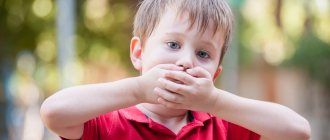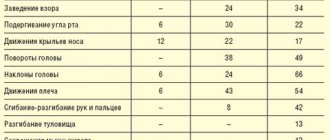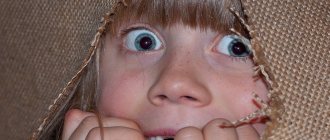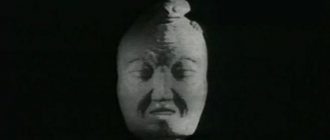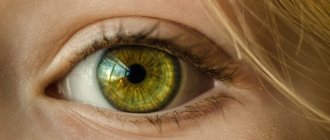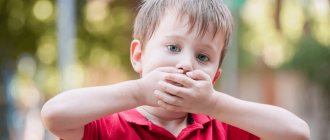Increased anxiety in a child: signs
The second most common problem after behavioral disorders in children is increased anxiety. Its signs are found in 8% of children. And unfortunately, this figure is growing.
What is anxiety? These are episodic manifestations of fear. Each age has its own, and we’ll talk about it below. Anxiety is an absolutely normal manifestation if it is caused by specific circumstances. If it is present in the “background”, we can talk about pathology.
In other words, any child can become agitated and begin to worry if some exciting event occurs in his life, even if it is pleasant, but in ordinary life he is calm and joyful. A child with signs of increased anxiety practically cannot relax, and constantly experiences anxiety - when he is in a familiar environment, when visiting, on a holiday, in the park, when a stranger addresses him, etc.
The main difficulty in diagnosing increased anxiety in children is that while they are small, they cannot accurately tell about the problem, and closer to adolescence they can persistently deny them. Here are some signs of increased anxiety in your child that you should be wary of:
Behavioral:
- fussiness;
- motor restlessness;
- repetitive obsessive movements - finger sucking, hair curling, nail biting;
- sleep disorders;
- stiffness;
- panic fear of the new, of any change;
- diffidence;
- refusal of new activities;
- seriousness;
- reluctance to stand out and desire for silence;
- frequent fears for no reason;
- low self-esteem.
Somatic signs
(the child may not talk about them, and they may also be associated with certain diseases).
If you suspect increased anxiety in your child, you should focus on a combination of somatic and behavioral signs.
- hot flashes or chills;
- tremor or shaking;
- cardiopalmus;
- chest discomfort or pain;
- feeling of a lump in the throat;
- difficulty breathing;
- fainting or dizziness;
- muscle tension;
- numbness or tingling;
- feeling of “emptiness in the head”;
- a feeling of the unreality of objects or the separation of one’s own “I”.
American psychologists P. Baker and M. Alvord advise paying attention to whether the child’s behavior has the following signs: constant anxiety, difficulty, sometimes inability to concentrate on anything, muscle tension (for example, in the face, neck), irritability, sleep disturbance.
Test for a child's anxiety level
If you notice signs of increased anxiety in your child, we recommend that you conduct a small test to clarify.
Questionnaire
Lavrentieva G. P. and Titarenko T. M.
Answer yes if you agree with the statement and no if the statement does not apply to your son or daughter:
1. Your child cannot work for a long time without getting tired 2. Has difficulty concentrating 3. Any task causes unnecessary anxiety 4. Is very tense and constrained in completing tasks 5. Is embarrassed more often than others 6. Often talks about tense situations 7. As a rule, blushes or turns pale in an unfamiliar environment 8. Complains that he has terrible dreams 9. His hands are usually cold and wet 10. Often suffers from upset bowel movements 11. Sweats a lot when he is excited 12. Does not have a good appetite 13. Has difficulty falling asleep, sleeps restlessly 14. Shy, many things cause him fear 15. Usually restless, easily upset 16. Often cannot hold back tears 17. Does not tolerate waiting well 18. Does not like to take on new things 19. Not confident in himself and his abilities 20. Afraid to face challenges difficulties
For each positive answer, count 1 point:
If the total number of points reaches 15-20 points, then your child has increased anxiety; 7-14 points—average; 1-6 points—low
The important role of the psychologist in helping the child and parents
You shouldn’t think that it will outgrow... Children’s fears are rarely forgotten; they follow us into adulthood and then become the causes of phobias, panic, and more. If the baby is not helped to cope with his conditions, he will experience severe psychological stress. And it, in turn, affects physical and mental development.
Parents cannot always help their children on their own. After all, it’s not enough to just talk or calm down. Therefore, their assistant becomes a children's psychological center, where professional psychologists, using special techniques, will help the child cope with fear, understand the cause and get rid of obsessive states. The main methods used are drawing, fairy tale therapy and games. But it is important to remember that working with a baby is built separately in each case.
Only with the help of parents and a child psychologist will the child be able to overcome his fears and stop being afraid.
Fears in childhood
D. Icke defines fear as a mental phenomenon that anyone can observe in themselves almost every day. Fear is an unpleasant emotional experience when a person, to one degree or another, realizes that he is in danger.
A. Kempinski notes in his work that when it comes to defining concepts such as, for example: fear, horror, apprehension, anxiety, etc., it is impossible to give a clear definition. The author believes that this always happens when we are talking about concepts associated with the most personal experiences. They can be felt, but difficult to define, he argues [10].
According to E. Stepanova, fears are emotionally charged feelings of anxiety in response to a real or imagined threat to life and well-being. In a situation of obvious danger to life, for example, fainting, suffocation, sudden loss of balance, falling, etc., fear is instinctive in nature and represents a defensive reaction, a means of defense.
According to A.I. Zakharov, fear is one of the fundamental human emotions that arises in response to a threatening stimulus. If we consider the emotion of fear objectively, then, despite its negative connotation, we can state the fact that fear performs many functions in a person’s life. Throughout the entire period of human development, fear accompanied people, manifesting itself in the fear of the dark, natural phenomena, and fire. Fear acted as the organizer of people's struggle with the elements. Fear allows you to avoid danger, since it played and plays a protective role. Therefore A.I. Zakharov believes that fear can be considered as a natural accompaniment of human development [6].
A. I. Zakharov notes that fear can develop in a person at any age: in children from 1 to 3 years old, night fears are not uncommon; in the 2nd year of life, the most common are the fear of unexpected sounds, the fear of being alone, the fear of pain and related fear of medical workers. At the age of 3-5 years, children are characterized by fears of loneliness, darkness and confined spaces. From 5 to 7 years old, the leading fear is the fear of death. From 7 to 11 years old, the biggest fear for children is “not being well spoken, respected, appreciated and understood.”
According to G. Eberlein, the presence of persistent fears in children indicates an inability to cope with their feelings and control them. In such cases, children get scared instead of acting, and cannot stop the “raging” feelings [13, p.29].
Let's talk about the characteristics of children's fears. Children's fears are a normal part of childhood development. They have different meanings for a child. Fear, like any experience, is useful when it fulfills its functions and then disappears, but when fear does not disappear for a long time or the child has a large number of fears, then we can talk about the child’s pre-neurotic state, which, in turn, can turn into anxiety neurosis, which is a pathological condition in which a child develops a state of mental tension, stiffness, behavior becomes more passive, and instead of spontaneity and openness, isolation and detachment develop. If fears persist for a long time, this is a sign of trouble, indicating a child’s nervous disorder, incorrect parental behavior, the possible presence of fears themselves, and conflictual relationships in the family. If fears persist for a long time, or if there are pronounced fears, the child needs help in overcoming them. The lack of timely psychological assistance can lead to the development of anxiety as a stable personality trait, lack of confidence in oneself and peers, and aggressiveness, which in the future can become an obstacle to the development of behavioral skills.


